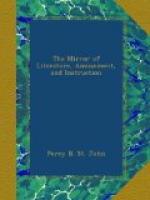Cartoon is derived from the Italian cartone, a painting or drawing upon large paper. Raphael died on the same day of the year on which he was born, Good Friday, in 1520, at the age of thirty-seven, deeply lamented by all who knew his value. His body lay for awhile in state in one of the rooms wherein he had displayed the powers of his mind, and he was honoured with a public funeral; his last produce, the transfiguration, being carried before him in the procession. The unrelenting hand of death (says his biographer) set a period to his labours, and deprived the world of further benefit from his talents, when he had only attained an age at which most other men are but beginning to be useful. “We see him in his cradle (said Fuseli); we hear him stammer; but propriety rocked the cradle, and character formed his lips.”
P.T.W.
* * * * *
TO MARY QUEEN OF SCOTS. WRITTEN ON VISITING WESTMINSTER ABBEY.
My murder’d queen, as on thine image
once
The gaze alike of prince and peasant rested—
As if, unsated of thy thrilling glance,
They never until then of beauty tasted:
So I, by lonely contemplation led
To muse awhile amid the silent dead—
Turn me from all around I hear or see—
From all of Shakspeare and of great to
thee:
And think on all thy wrongs—on
all the shame
That dims for ever thine oppressor’s
name;
On all thy faults, nor few nor far between,
But then thou wert—a woman
and a queen.
Proud titles, even in a barb’rous
age,
To stem th’ impetuous tide of party
rage;
While as I gaze each well-known feature
seems
To stir with life, and realise my dreams
That paint thee seated on the Scottish
throne,
With all the blaze of beauty round thee
thrown;
Then see thee passing from thy dungeon
cell,
And hear thy parting sigh—thy
last farewell.
Stray Leaves.
* * * * *
ANCIENT GRECIAN SEPULCHRE
[Illustration]
A beautiful illustration of an ancient Grecian sepulchre or funeral chamber, heads the second chapter of Mr. Britton’s “Union of Architecture, Sculpture, and Painting,” from which work we have copied the annexed engraved view. The interior of the chamber exhibits a skeleton and the urns containing the ashes of the dead. The combat leads us to the conclusion, that the tomb contains the remains of a chief; for it was the barbarous custom of the Greeks to sacrifice captives at the tombs of their heroes.
Of the funeral rites and ceremonies of the Greeks and other nations, we subjoin the following:—
The most simple and natural kind of funeral monuments, and therefore the most ancient and universal, consist in a mound of earth, or a heap of stones, raised over the ashes of the departed: of such monuments mention is made in the Book of Joshua, and in Homer and Virgil. Many of them still occur in various parts of this kingdom, especially in those elevated and sequestered situations where they have neither been defaced by agriculture nor inundation.




